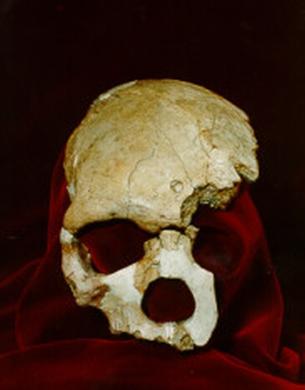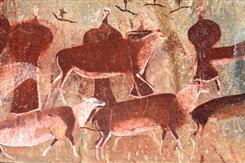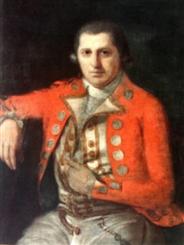First humans
Long ago the mountains, savannas and deserts of the Orange River basin were the range of eland, kudu and springbok; lion, hyena and jackal. The region (including the neighbouring Limpopo River basin) also contains the caves that provide some of the earliest evidence of man’s origins. These are the so-called “Cradle of Humankind”, 30 kilometres west of Johannesburg. They have been proclaimed a UNESCO World Heritage Site, and palaeontologists have found hominid fossils that are 3.5 million years old. Archaic Homo sapiens settled in the Orange-Senqu basin during the Middle Stone age, approximately 700 000 – 125 000 years ago (Box 1).
Box: Florisbad, South Africa: Over 120 000 Years of Human Activity
Paleontological and archaeological interest in the Florisbad mineral spring site, which is located near Brandfort in the Free State Province of South Africa, dates to 1912, when stone artifacts and fossilised bones were recovered from the spring mound after an earthquake caused a new spring eye to erupt in the vicinity of a recently enlarged pool. Excavations at Florisbad during the 1920s and 1930s yielded interesting discoveries such as rare and distinct animal fossils. The site is internationally known for producing a pre-modern human skull, Middle Pleistocene fossil vertebrates and Middle Stone Age artifacts. The Florisbad skull is accepted as that of an archaic Homo Sapiens.

The Florisbad Skull.
Source:National Museum, Bloemfontein
( click to enlarge )
San
San hunter-gatherers appeared in the area some 40.000 years ago. They were living in highly mobile groups of between 20 and 50. Some followed the game around the country, and lived in close relationship with the land and its seasons. Others maintained a more settled life along the coastal regions, depending for food on seals, shellfish, crayfish, birds and the occasional beached whale.
The San have left a lasting record of their life through thousands of rock art paintings and engravings. Though more closely related to their cultural and spiritual life, some of the more recent paintings give a San perspective on those who came into their land and displaced them.
Khoi
About 2 500 years ago the San were joined by Khoi from the north-east (an area bordering modern Angola, Zambia and Botswana). The Khoi were pastoralists, who farmed cattle, sheep and goats. It is likely that the Khoikhoi developed their pastoral culture approximately 2000 years ago through contact with migrating Bantu tribes from further north; who were travelling down through Africa with domesticated herds of cattle, sheep, and goats.
Bantu
The Bantu-speaking peoples; coming from West Africa, also settled in southern Africa. They arrived in the Orange-Senqu River basin between 1300 and 1600 AD. Apart from keeping animals, they had long lived by agriculture, and planted sorghum, black beans and peanuts. The Bantu peoples did not migrate to the western parts of the basin, because their agro-pastoralist lifestyle was not supported by climatic conditions below the 200 mm rainfall barrier.
 San Rock Art. Source:Tusafiri 2007 ( click to enlarge ) |
 Robert Jacob Gordon (1870). Source:William Fehr Collection, Cape Town Castle ( click to enlarge ) |
Europeans
In 1488 the first Europeans arrived at the Cape, led by the Portuguese seafarer Bartolomeu Dias. Gradually Europeans advanced into the interior. When they heard about this big river further north, they called it “Vigiti Magna”. Dutch explorers were the first Europeans to reach the Vigiti Magna – though they first had to cross a seemingly endless desert. The first Europeans settled in the Orange-Senqu River basin in the 1690s. During the “Great Treck” of the 1830s and 1840s Boer settlers advanced further into the basin; the diamond and gold booms starting in the 1870s promoted the development of a partly industrialized South Africa, which was dominated by European settlers. Large-scale commercial farming was established between 1870 and 1900.
The River’s Name
The Khois’ name for the Orange-Senqu River downstream from the confluence of the Vaal River was Gariep, meaning “big water” or “great river”, whilst the upper part was known as Nu-Gariep or “Black River”. This name was also used by many Bantu settlers. The San called the Orange the “Dragon River”. The first Europeans talked of the “Vigiti Magna”; this was renamed the “Oranje Rivier” (Orange River) by Colonel Robert Gordon, commander of the Dutch East India Company garrison at Cape Town, in honour of Prince William of Orange. In Lesotho, where the river originates high in the Maluti Mountains, the Orange River is known as the Senqu Lesotho.
